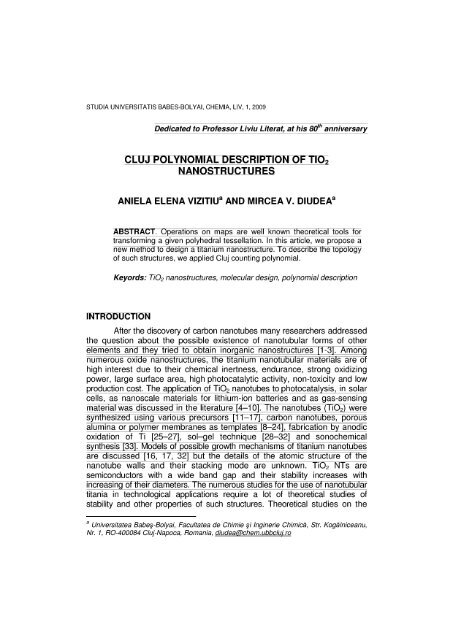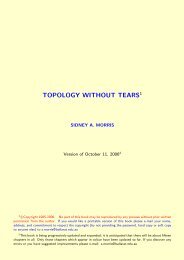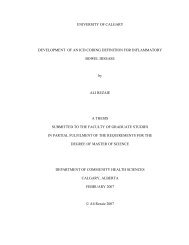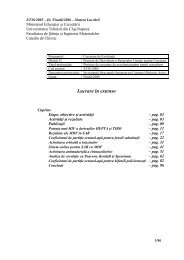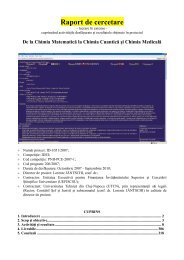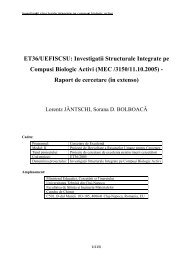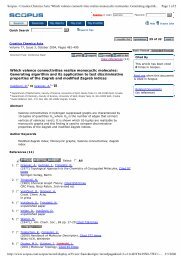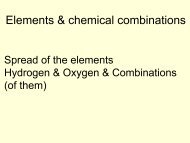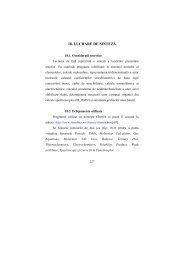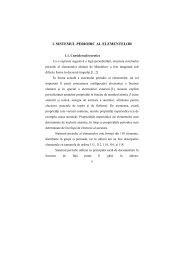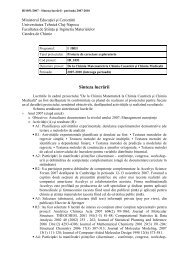cluj polynomial description of ti02 nanostructures - Catedra de Chimie
cluj polynomial description of ti02 nanostructures - Catedra de Chimie
cluj polynomial description of ti02 nanostructures - Catedra de Chimie
You also want an ePaper? Increase the reach of your titles
YUMPU automatically turns print PDFs into web optimized ePapers that Google loves.
STUDIA UNIVERSITATIS BABES-BOLYAI, CHEMIA, L1V, 1,2009<br />
Dedicated to Pr<strong>of</strong>essor Liviu Literat, at his sd h anniversary<br />
CLUJ POLYNOMIAL DESCRIPTION OF TI02<br />
NANOSTRUCTURES<br />
ANIELA ELENA VIZITIU a AND MIRCEA V. DIUDEA a<br />
ABSTRACT. Operations on maps are well known theoretical tools for<br />
transforming a given polyhedral tessellation. In this article, we propose a<br />
new method to <strong>de</strong>sign a titanium nanostructure. To <strong>de</strong>scnbe the topology<br />
<strong>of</strong> such structures, we applied Cluj counting <strong>polynomial</strong>.<br />
Keyords: Ti02 <strong>nanostructures</strong>, molecular <strong>de</strong>sign, <strong>polynomial</strong> <strong><strong>de</strong>scription</strong><br />
INTRODUCTION<br />
After the discovery <strong>of</strong> carbon nanotubes many researchers addressed<br />
the question about the possible existence <strong>of</strong> nanotubular forms <strong>of</strong> other<br />
elements and they tned to obtain inorganic <strong>nanostructures</strong> [1-3]. Among<br />
numerous oXi<strong>de</strong> <strong>nanostructures</strong>, the titanium nanotubular matenals are <strong>of</strong><br />
high interest due to their chemical inertness, endurance, strong oxidizing<br />
power, large surface area, high photocatalytic activity, non-toxicity and low<br />
production cost. The application <strong>of</strong> Ti02 nanotubes to photocatalysis, in solar<br />
cells, as nanoscale materials for lithium-ion batteries and as gas-sensing<br />
matenal was discussed In the literature [4-10]. The nanotubes (TI02) were<br />
syntheSized uSing vanous precursors [11-17], carbon nanotubes, porous<br />
alumlna or polymer membranes as templates [8-24], fabncatlon by anodlc<br />
oxidation <strong>of</strong> Ti [25-27], sol-gel technique [28-32] and sonochemical<br />
syntheSIS [33]. Mo<strong>de</strong>ls <strong>of</strong> pOSSible growth mechanisms <strong>of</strong> titanium nanotubes<br />
are discussed [16, 17, 32] but the <strong>de</strong>tails <strong>of</strong> the atomic structure <strong>of</strong> the<br />
nanotube walls and their stacking mo<strong>de</strong> are unknown. TI02 NTs are<br />
semiconductors with a wi<strong>de</strong> band gap and their stability increases with<br />
Increasing <strong>of</strong> their diameters. The numerous studies for the use <strong>of</strong> nanotubular<br />
titania in technological applications require a lot <strong>of</strong> theoretical studies <strong>of</strong><br />
stability and other properties <strong>of</strong> such structures. Theoretical studies on the<br />
a Universitatea Babe§-Bolyai, Facultatea <strong>de</strong> <strong>Chimie</strong> §i Inginerie Chimica, Str. Kogalniceanu,<br />
Nr. 1, RO-400084 Cluj-Napoca, Romania, diu<strong>de</strong>a@chem.ubb<strong>cluj</strong>.ro
ANIELA ELENA VIZITILJ AND MIRCEA V DIlJDEA<br />
stability and electronic charactenstlcs <strong>of</strong> TI02 <strong>nanostructures</strong> were presented<br />
in ref. [34, -36]. In the present paper we report a new method to <strong>de</strong>sign<br />
Ti02 <strong>nanostructures</strong> using map operations, and then we <strong>de</strong>scribe their<br />
topology by the CluJ <strong>polynomial</strong>.<br />
RESULTS AND DISCUSSION<br />
Mo<strong>de</strong>ls and computational method<br />
The titanium <strong>nanostructures</strong> can be achieved by map operations:<br />
the sequence consists <strong>of</strong> DU[Med(M )], applied on the polyhex ton or tubes<br />
(Figure 1).<br />
(a) Du[Med(TOH(8,8))] (b) Du[Med(H832)]<br />
Figure 1. Ti02 nanotube (a) and nanotorus (b).<br />
A map M is a combinatorial representation <strong>of</strong> a (closed) surface [37,38].<br />
Several transformations (I.e., operations) on maps are known and used for<br />
various purposes.<br />
Let us <strong>de</strong>note in a map: v - the number <strong>of</strong> vertices, e - the number<br />
<strong>of</strong> edges, f - the number <strong>of</strong> faces and d - the vertex <strong>de</strong>gree. A subscript "0"<br />
Will mark the corresponding parameters In the parent map.<br />
Recall some baSIC relations In a map:<br />
Is Is =2e<br />
where Vd and fs are the number <strong>of</strong> vertices <strong>of</strong> <strong>de</strong>gree d and number <strong>of</strong> sgonal<br />
faces, respectively.<br />
174<br />
(1 )<br />
(2)
ClUJ POLYNOMIAL DESCRIPTION OF TI02 NANOSTRUCTURES<br />
Medial Me<br />
Medial is achieved by putting new vertices in the middle <strong>of</strong> the<br />
onglnal edges [38]. JOin two vertices If the edges span an angle (and are<br />
consecutive within a rotation path around their common vertex in M).<br />
Medial is a 4-valent graph and Me(M) = Me(Du(M)), as illustrated in Figure<br />
2. The transformed map parameters are:<br />
The medial operation rotates parent s-gonal faces by TT/S. Points in<br />
the medial represent onglnal edges, thus this property can be used for<br />
topological analysis <strong>of</strong> edges in the parent polyhedron. Similarly, the points<br />
in dual give information on the topology <strong>of</strong> parent faces.<br />
(a) (b)Me[TUH(8,4)] (b)Me[H(8,8)]<br />
Dual Du<br />
Figure 2. Medlals <strong>of</strong> a polyhex nanotube.<br />
The duallzatlon <strong>of</strong> a map starts by locating a pOint In the center <strong>of</strong><br />
each face. Next, two such points are joined if their corresponding faces<br />
share a common edge. It IS the (POInCarE3) dual Du(M). The vertices <strong>of</strong><br />
Du(M) represent the faces <strong>of</strong> M and vIce-versa [38].<br />
Figure 3. The duals <strong>of</strong> the Platonic polyhedra.<br />
(3)<br />
175
180<br />
ANIELA ELENA VIZITILJ AND MIRCEA V DIlJDEA<br />
34. V. V. Ivanovskaya, A. N. Enyashln, A. L. Ivanovskll, Men<strong>de</strong>/eev Gomm. 2003,<br />
13,5.<br />
35. V. V. Ivanovskaya, A. N. Enyashln, A. L. Ivanovskll, Russ. J. /norg. Chem.<br />
2004,49,1.<br />
36.A. N. Enyashin, G. Seifert, Phys. Stat. Sol. 2005 , 242, 7, 1361.<br />
37.P. W. Fowler and T. Pisanski, J. Chem. Soc. Faraday Trans., 1994, 90,2865.<br />
38.T. Pisanski and M. Randic, in Geometry at Work, (Ed. C. A. Gorini) M. A.<br />
A. Notes, 2000, 53, 174.<br />
39.M.V. Diu<strong>de</strong>a, I. Gutman, L. Jantschi, Molecular Topology. Nova Science,<br />
Huntington, New York, 2001.<br />
40.M. V. Dlu<strong>de</strong>a, Cluj MatriX Invariants. J. Ghem. /nt. Gomput. SC!. 1997, 37,300.<br />
41.M. V. Diu<strong>de</strong>a, B. Parv, I. Gutman, Detour-Cluj Matrix and Derived Invariants.<br />
J. Ghem. /n'- Gomput. SC!. 1997, 37, 1101.<br />
42.M. V. Dlu<strong>de</strong>a, G. Katona, I. LukoVltS, N. Trlnajstlc, Detour and Cluj-Detour<br />
Indices. Groat. Ghem. Acta, 1998, 71,459.<br />
43.D. Opris, M. V. Diu<strong>de</strong>a, Pepti<strong>de</strong> Property Mo<strong>de</strong>ling by Cluj Indices.<br />
SARIOSAR Env!ron. Res. 2001, 12,159.<br />
44.M. V. Dlu<strong>de</strong>a, Cluj Polynomials. Stud!a Un/v. "Babes-Ba/rat': 2002, 47, 131.<br />
45.0. Orsu, M. V. Dlu<strong>de</strong>a, TOPOCLOJ s<strong>of</strong>tware program, Babes-Bolyal<br />
University, Cluj, 2005; Available, on line at http://chem.ubb<strong>cluj</strong>.ro/-diu<strong>de</strong>a.<br />
46.M. V. Dlu<strong>de</strong>a, A. E. VIZltIU, D. Janezlc, Cluj and related <strong>polynomial</strong>s applied<br />
in correlating studies, J. Chem. Int. Mo<strong>de</strong>l., 2007, 47(3), 864.<br />
47. I. Gutman, S. Klavzar, An AlgOrithm for the Calculation <strong>of</strong> the Szeged In<strong>de</strong>x <strong>of</strong><br />
Benzenold Hydrocarbons. J. Ghem. /n'- Gomput. SC!. 1995, 35, 1011.<br />
48.M. V. Dlu<strong>de</strong>a, In: M. V. Dlu<strong>de</strong>a, Ed., Nanostructures-Novel Architecture,<br />
NOVA, New York, 2005,111.


